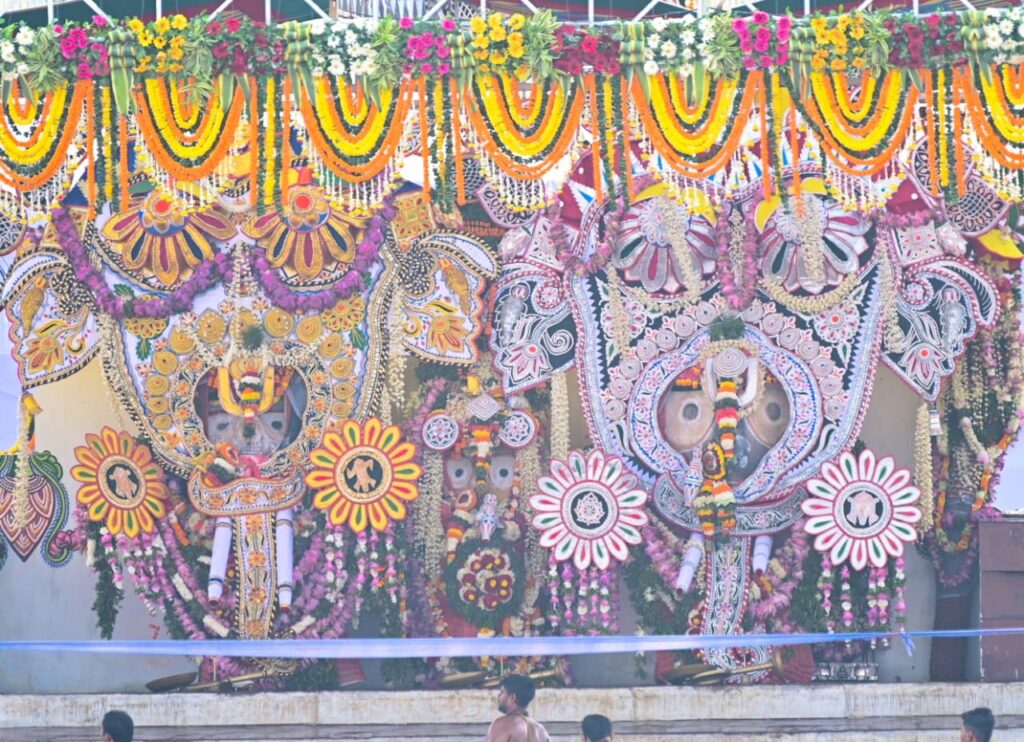The Gajanana Besa, or the Elephant Head Attire, of Lord Jagannath is a significant ritual observed during the Snana Purnima, the full moon day of the Hindu month of Jyestha. This festival, also known as Deba Snana Purnima, marks a pivotal moment in the Jagannath temple rituals in Puri, Odisha. It is a day of profound spiritual and cultural importance, symbolizing transformation, renewal, and divine grace.Snana Purnima is celebrated as the divine bathing festival of Lord Jagannath, along with his siblings Balabhadra and Subhadra. According to mythology, this event commemorates the Devasnana, the ceremonial bathing of the deities, which is believed to have a purifying and rejuvenating effect on them. On this day, the deities are brought out from the sanctum sanctorum to the Snana Mandap (bathing altar), where they are bathed with 108 pots of herbal and aromatic water drawn from a special well called Suna Kua.Gajanana Besa: The Elephant AttireAfter the elaborate bathing ritual, the deities are dressed in the Gajanana Besa, resembling the elephant-headed god, Ganesha. This attire involves adorning Lord Jagannath with a large, intricately designed headpiece that resembles an elephant’s head. The origin of this practice is linked to an ancient legend where Lord Jagannath assumed the form of Gajanana (Ganesha) to satisfy the wishes of his devotees and to symbolize the removal of obstacles.Symbolic SignificanceTransformation and Renewal: The Gajanana Besa signifies a transformation that the deities undergo. The bathing ritual and subsequent dressing represent a form of renewal, purifying the deities and preparing them for the upcoming Rath Yatra festival. This transformation is a metaphor for the spiritual cleansing and renewal that devotees seek in their own lives.Divine Grace: Lord Jagannath in the form of Gajanana symbolizes divine grace and the removal of obstacles. Ganesha is widely revered as the remover of obstacles and the harbinger of good fortune. By donning the Gajanana Besa, Lord Jagannath blesses his devotees with the qualities associated with Ganesha, including wisdom, prosperity, and protection from harm.Cultural Integration: The Gajanana Besa also highlights the syncretism in Hindu worship practices. It reflects the integration of various deities and their attributes into the worship of Lord Jagannath, showcasing the inclusiveness and adaptability of Hindu traditions.On Snana Purnima, thousands of devotees gather to witness this grand event. The deities, adorned in the Gajanana Besa, are displayed for public darshan (viewing), which is considered highly auspicious. The sight of Lord Jagannath in this unique form is believed to grant devotees the same blessings and boons as those from Ganesha.After the Snana Purnima, the deities are believed to fall ill due to the extensive bathing and are kept in a secluded place called Anasara Ghara for a period of 15 days. During this time, they are unavailable for public viewing. This period of seclusion is seen as a time of rest and recuperation for the deities before they reappear in their rejuvenated form during the Rath Yatra.The Gajanana Besa of Lord Jagannath on Snana Purnima is a profound ritual that encapsulates the themes of transformation, divine grace, and cultural synthesis. It is a testament to the rich tapestry of rituals and beliefs that define the worship of Lord Jagannath and the broader Hindu tradition. This sacred attire and the rituals surrounding it not only enhance the spiritual ambiance of the festival but also deepen the devotees’ connection to the divine, fostering a sense of renewal and spiritual upliftment.
Gajanana Besa of Lord Jagannath on Snana Purnima: A Divine Symbol of Transformation and Renewal








